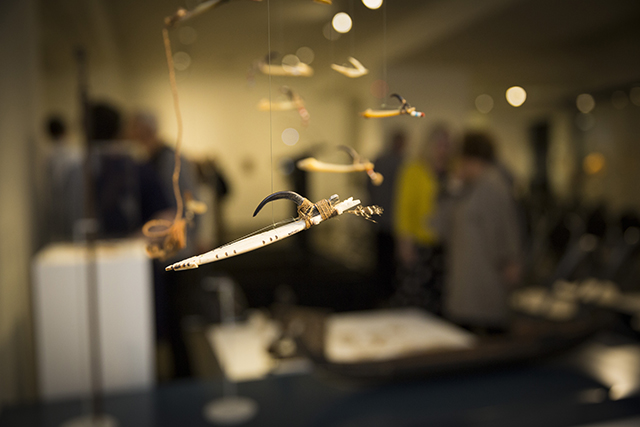
A collection based collaborative exhibition of materials held at UQ from, and about, Solomon Islands
19 August 2016 - 14 July 2017
This is only the second exhibition in Australia devoted to Solomon Islands in recent years, although Honiara, the modern capital of Solomon Islands is closer to Brisbane than Auckland.
Among the 28,000 items that the UQAM is privileged to care for are more than five hundred remarkable things and images recorded as being from Solomon Islands.
This exhibition offers something glimpsed and partial suggested by the contents of this collection and by some contemporary works. It isn’t intended as a survey show of Solomon Island work but aims to return the Solomon collection things to an enchanted state (Hillman 1982), one that is alive with new possibilities for shaping the present and the future.
The exhibition is also a first step towards adding some layers of meaning to the poorly documented Solomon Islands collection and a way of inviting a response from anyone who has an interest in it. Blank labels are available for anyone with such an interest to add knowledge and meaning to the exhibition by writing their own label and adding it to the wall.
The show is arranged around several narratives and counter narratives that include:
• Heads and tales. Head hunting canoes and their contemporary visual manifestations through carvers working around Marovo Lagoon, Western province. It includes contemporary sculptures and wood block prints by George Borgus, Aldio Pita, Leuten Watts-Hila, Milton Moloka, Gaspar, Terrence, Ralph Ako and stories from Leuten Watts-Hila and Eutucus Ngonga all from villages in Marovo Lagoon in the New Georgia Islands group.
• Shells. Worked shells as rings, inlaid pearl and beads.
• Malaitans and the labour trade. The role of batons in naming Solomon Islands and in ritual killing. The batons are displayed with Malaitan clubs and Malaitan men’s body wear.
• Labour trade collected photographs. The unique collection of photographs assembled by the Queensland labour trader Douglas Rannie with hand written captions from his manuscript in the UQ collection.
• Music. The case of stolen copyright and a Malaitan (Baegu) lullaby and music objects from the UQ collection with napa dance clubs from Santa Cruz.
• Contemporary film made by Wantok Stori.
One powerful reason for there being so many Solomon Islands things here is Brisbane’s centrality to the Queensland Labour Trade. Between 1870 and 1911 Queensland and Fiji received 24,865 Solomon Island labourers, out of a total Solomon’s population of around 150,000 to work on its sugar plantations (Moore 1990; 2015). The UQ collection is haunted by the final decades of this trade in the sense that the existence of the trade is responsible for many of the older things being here in Brisbane. The content of the collection doesn’t record the experience of Solomon Island labourers, nor by-and-large the things that they gained as part of payment for it. What this museum does have documented are some details of the careers of sailors and plantation owners, missionaries and legislators. Unpicking the connections of the collectors is often revealing but ultimately unsatisfying.
Diana Young.

Acknowledgements
Since 2012 the Museum’s registrar and curatorial assistant for this exhibition Camella Hardjo has been working with Graham Baines and Evelyn Tetehu Baines to add some meaning to the poorly documented Solomons collection. Later David Akin visited in 2013.
David Akin is an anthropologist who has been working with Malaitans, particularly Kwaio people, over the past 37 years. With his former wife Kathleen Gillogly he helped the Kwaio people establish the Kwaio Cultural Centre from 1979-1983, which included a Kwaio Arts project that encouraged the revival or proliferation of many Malaitan art forms.
Dr Graham Baines, Honorary Research Fellow, School of Social Science, University of Queensland, worked with Solomon Islands government agencies 1981-1989 during which time, through extended village visits, he developed a keen interest in Solomon Islander cultures and artefacts. He assists his wife, Evelyn, with the Santa Isabel Cultural Heritage Programme.
Clive Moore, an Emeritus Professor, has been visiting Solomon Islands since 1976 and in 2005 was awarded a Cross of Solomon Islands for his historical work on Malaita Island.
Honorary Associate Professor Annie Ross has worked in Marovo Lagoon for over a decade, documenting local cultural traditions and stories from the past and the present that link local people to their land and sea heritage.
Dr Diana Young is Director UQ Anthropology Museum/Senior Lecturer. One of her research interests is re inventing ethnographic museums for the twenty first century. She has researched, co-curated and commissioned a number of exhibitions based around the University of Queensland Anthropology Museum’s Pacific collections.
Credits
Director of project research and curation: Dr Diana Young
Curatorial and research assistance: Camella Hardjo
Research consultants:
Emeritus Professor Clive Moore
Dr Graham Baines
Mrs Evelyn Tetehu Baines
Honorary Associate Professor Annie Ross and her research consultants
David Akin, independent scholar
With thanks to:
Ben Burt, British Museum
Shirley Mwanesalua, curator, Solomon Islands National Museum
Lawrence Foana’ota, former Director of Solomon Islands National Museum
Oliver Lueb, Rautenstrauch-Joest Museum – Cultures of the World
Anna Craven, Foundation Director of Solomon Islands National Museum
Rebecca Conway, The Macleay Museum University of Sydney
Chantal Knowles, Queensland Museum
Jill Hassel, British Museum
Yvonne Carrillo-Huffman, Australian Museum
Members of SIIN network
The Edge-Partington family
Rosita Henry and James Cook University
Project management: Jane Willcock
Media arrangement, exhibition installation: Kiri Chan
Conservation: Kate Stanway
Additional literature research assistance: Sarah Webb, Jane Willcock
Photography: Carl Warner
Student intern: Alex Dwyer
Exhibition based on an idea by Diana Young

